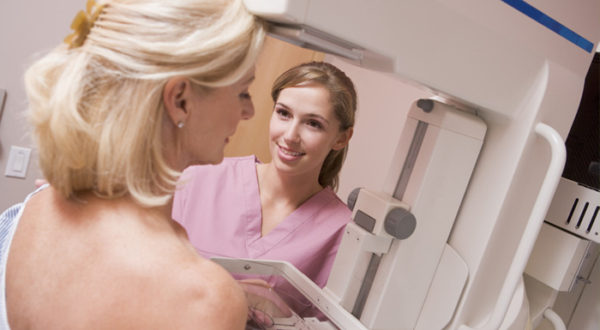Breast cancer is the most common cancer in women with more than 200,000 cases detected every year. Early detection offers the best chance for remission. Screening for breast cancer means checking the breasts for cancer before there are any signs or symptoms. Screening with a mammogram (a special kind of x-ray of the breast) has been shown to be the best way to detect early breast cancer by finding cancers that are small and easier to treat, thereby reducing the risk of death from breast cancer.

Advances in Mammography
The field of mammography has advanced greatly in the last two decades. Digital mammography was introduced in the early 2000s and has become widely available, essentially replacing film- screen mammography. More recently, 3D mammogram, or Tomosynthesis, was approved by the FDA in 2011 and is being used in many centers. A conventional mammogram (digital or film-screen) performs two x-rays of each breast and creates a two-dimensional image of the breast.
The 3D mammogram takes many images of the breast from varying angles, thereby simulating a three-dimensional image. The woman is positioned the same way as a conventional mammogram, but rather than 2 images, the x-ray machine takes multiple images while sweeping in an arc over the breast. As many more images are taken, the 3D exam takes slightly longer to perform than the 2D exam.
Comparing 3D to 2D Mammograms
These multiple 3D images are viewed on special monitors either as a scrolling movie or as multiple thin images by the radiologist. By having multiple images to read, the radiologist has more information to detect potential breast abnormalities. This helps detect more breast cancers earlier, and reduces the chance of additional imaging for a false positive mammogram. One of the main limiting factors in interpreting mammograms is the breast density – which is the amount of actual breast tissue a woman has. Small abnormalities can be potentially hidden and missed in a mammogram from a woman with denser breasts (more breast tissue). A conventional 2D mammogram, by virtue of creating two images of the breast has more chances of “hiding” abnormalities surrounded by dense tissue. Even though this is far less a problem with digital mammogram compared to film screen imaging, it could not be completely eliminated, thereby leading to potentially missing small cancers as well as needing additional tests to evaluate abnormalities that are not cancers.
One of the main limiting factors in interpreting mammograms is the breast density – which is the amount of actual breast tissue a woman has. Small abnormalities can be potentially hidden and missed in a mammogram from a woman with denser breasts (more breast tissue). A conventional 2D mammogram, by virtue of creating two images of the breast has more chances of “hiding” abnormalities surrounded by dense tissue. Even though this is far less a problem with digital mammogram compared to film screen imaging, it could not be completely eliminated, thereby leading to potentially missing small cancers as well as needing additional tests to evaluate abnormalities that are not cancers.
Watch: 3-D Mammography Now Available at Harrington
A 3D mammogram, by creating multiple thin slices, strives to eliminate this tissue overlap and make it easy to see through dense breast tissue. It has been shown to image dense breasts better than traditional mammograms but is also beneficial in women without dense breasts. Studies have shown increase in cancer detection of up to 30% and reducing the need for additional imaging in up to 20% of patients. Reducing the need to return after an abnormal screening exam is greatly beneficial in decreasing the anxiety related with waiting and unnecessary medical tests as well as cost.
Is 3D Really “Better”?
Although a 3D mammogram is considered better than the 2D for some women, especially those with dense breasts, a 2D digital mammogram remains the standard of care and offers equivalent diagnostic information in most women. Screening with 2D is not inferior to screening with a 3D mammogram in most women.
The choice to obtain a screening mammogram every year and the choice of 2D versus 3D should be only made after discussing the risks and benefits of screening along with individual risk factors for breast cancer with your doctor.